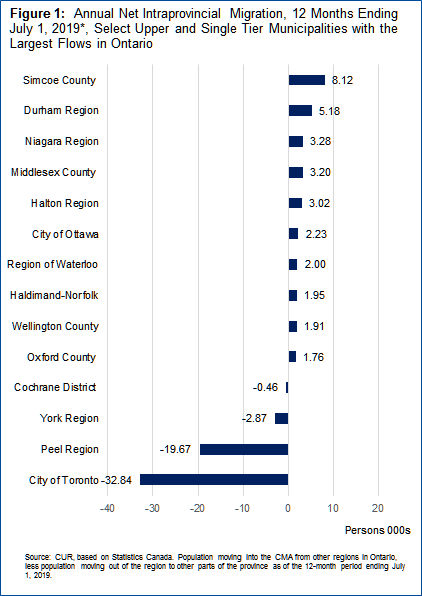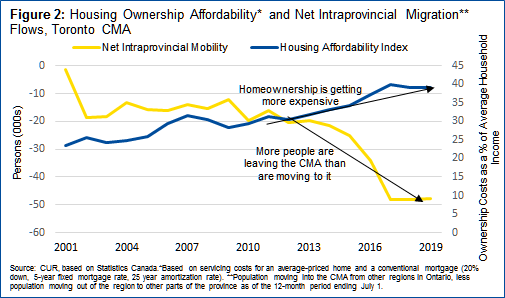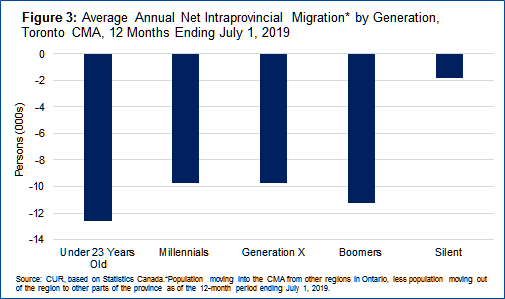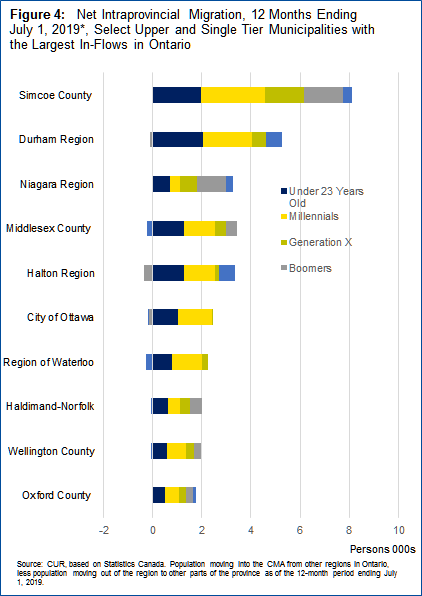Toronto CMA Losing Existing Population of All Ages to More Affordable Regions in Ontario
By: Diana Petramala
(PDF file) Print-friendly version available
March 11, 2020
This blog is the second in a series of two looking at population flows. CUR’s first blog looked at where Millennials were moving to and from across Canada. The focus of this blog is on net population flows in and out of municipalities within Ontario by generation in the 12 months ending July 1, 2019.[1]
In other words, we are focusing on net intraprovincial migration flows – the difference between the number of people moving in an out of municipalities from within Ontario.
The Net Population Outflow from the Toronto CMA Was Sizeable Again in 2019
Figure 1 shows that municipalities within the Toronto Census Metropolitan Area (CMA) had a sizeable net outflow of people moving within the province in the 12-month periods ending on July 1, 2019. Net outflows were largest for the city of Toronto and the region of Peel.

All other municipalities (census divisions) in Ontario had a positive inflow of people when it comes to intraprovincial migration (with the exception of the Districts of Thunder Bay, Kenora and Cochrane) though many had relatively little flows.
What is more, Figure 2 shows that these outflows of people have accelerated since 2013 as housing has become increasingly expensive in the Toronto CMA. The figure plots net interprovincial migration flows against homeownership affordability in the region and shows that a sharp deterioration in housing affordability has been mirrored by the acceleration in net population outflows from the region.

This trend is evident among all generations, not just those in the first-time home buying age, i.e. Millennials. Figure 3 shows that on net persons in all generations left the Toronto CMA and moved to other parts of the province in 2019, though this is less the case for the Silent Generation.[2]

Who Is Going Where?
Figure 4 shows net intraprovincial migration flows by municipality within the GGH and the rest of Ontario for the regions with a net inflow of people for each of the five generations.
Simcoe Country was a top destination for all generations in the 12-months ending in 2019. Those under 23 years old in 2019 and Millennials also favoured Durham Region, while Boomers and Generation X favoured the Niagara Region. Boomers were more likely to move further from the Toronto CMA than the younger populations. Meanwhile, a large number of Millennials were also moving to Middlesex county, Halton region, city of Ottawa and the region of Waterloo.
Note that those that are younger than 23 years old move in part because they move with their parents.

Conclusion
On net, households within the Toronto CMA are moving out of the region mostly in search of more affordable ground-related housing.
It should be noted, however, that immigration into the Toronto CMA is more than offsetting these intraprovincial migration net outflows. The population in the city of Toronto, and the regions of Peel and York, grew by an annual average of 46,000, 43,000 and 19,000 people per year, respectively, in the 12 months ending July 1 in 2019.
_________________________________________________________________________________________________________
Sources:
[1] The annual intercensal population estimates are for census divisions. In Ontario, the largest single-tier municipalities and regional municipalities are separate census divisions (e.g., the cities of Toronto and Hamilton and the regional municipalities of Peel, Halton, York and Durham. For counties, the census division populations include incorporated municipalities within the county. These estimates are preliminary estimates and are subject to revisions with next year’s release.
[2] Millennials are defined as those born between 1981 and 1996; Generation X are those born between 1965 and 1980; Boomers are born between 1946 and 1964; Silent Generation are those born before 1946. The under 23 age group includes generation Z.
Diana Petramala is Senior Researcher at Toronto Metropolitan University's Centre for Urban Research and Land Development (CUR) in Toronto.